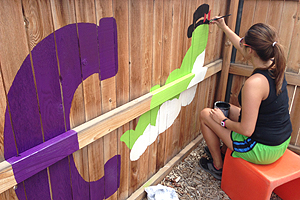All in a Day's Work: Students Get Hands On With Occupational Therapy

Community projects create awareness about the profession and its benefits, and also gives students a different perspective on care.
To a group of second-year students in Master of Occupational Therapy Professor Cynthia Tiongco’s Health and Community Settings course, an occupation isn’t just a job and neither is occupational therapy.
“We’re not here just because we know there’s career options when we finish, or there’s a nice paycheck at the finish line,” said Ashley Stevens. “We know we’re taking this job because of a. the opportunities we have at the finish line, but b. because of the meaning that we serve for so many people.”
Stevens and her classmates spent the summer working on community projects to help underserved and disabled Lubbock residents of all ages meet the needs of all of the different roles (or occupations) they take on in their lives friend, parent, grandparent, teacher, etc.
Occupational therapy or the art and science of helping people do day-to-day activities that are important and meaningful to their health and well-being is one of the fastest growing jobs in the U.S., according to the Bureau of Labor Statistics. This is due in part to an aging population and better diagnosis of certain conditions like autism, mental illness and ADHD.
Tiongco, OTR, MOT, said getting her students into the community creates awareness about occupational therapy and its benefits, but also gives future health care providers a different perspective on care.
“These projects get the students out of their comfort zone …[into] the communities that they’re sending their clients home to, and then help to make them a little bit better,” Tiongco said.
Close to the Heart
Last semester when it came time for Stevens and her partner Josie West to choose a community lab site, the two were immediately drawn to the Silver Star Program of All Inclusive Care for the Elderly (PACE) program.
Stevens and West said geriatric and adult care is especially close to their hearts because their grandparents inspired them to study occupational therapy.
“When you watch someone you love recover because of somebody or something they did, it just changes you,” Stevens said. “When you see that connection — that someone wants to really love on the person that you love within their job, how can you deny that?”
West and Stevens worked with the Silver Star activities coordinator to construct plywood sensory boards consisting of materials like silk, cotton, beads, carpet and sandpaper that could be manipulated by participants with dementia and Alzheimer’s disease to elicit happy memories through touch and smell.
“[Sensory activities] really help lower aggressive behaviors … frustration, those types of things,” West said. “It may also help with calming sensations and help them become more relaxed in their environment.”

The use of sensory boards in occupational therapy can help calm patients and lower aggressive behavior.
The students also built an activity board filled with simulated activities of daily living including a belt, Velcro, buttons, zippers and clothespins to help Silver Star participants practice fine motor skills and pinch strength.
“We definitely wanted to incorporate some sort of functional element into the sensory kits,” West said. “We wanted it to be some sort of purposeful activity.”
The sensory boards West and Stevens helped create will remain at PACE and will be maintained by the Student Occupational Therapy Association for clients to use in the future.
“There were some really great responses from the clients to the sensory kits that we presented,” West said. “A few of the clients just immediately started to feel and manipulate the items and it just seemed like a really positive response.”
Fit for Life
Joseph Sandefer’s decision to switch from physical therapy to occupational came after his aunt suffered a stroke. Although he is interested in pursuing the medical model of occupational therapy when he graduates, Sandefer said improving quality of life is his overall career goal.
“No matter where we feel that our experience lies or where our hearts being drawn as far as where we’re going to work as therapists, we’re going to send them home, and it’s really important to know where you’re sending them,” Sandefer said. “We pride ourselves on being holistic therapists part of our goal as occupational therapists is not only getting them better, but keeping them better.”
A wholesome diet and regular exercise are keys to staying healthy, Sandefer said. That’s why his group worked with the LIFE/RUN Center for Independent Living to improve access to local and fitness and nutrition resources for people with disabilities.
“We feel as occupational therapists that [health and fitness] is a huge preventative for illness, injury and disability,” Sandefer said. “And if a person is already within that category … it’s a preventative for further issues. We know through research that recovery is possible and easier through a healthy and fit lifestyle.”
Sandefer’s group advocated for LIFE/RUN customers by following up with letters requesting gym or diet and nutrition education support from health and wellness centers throughout Lubbock.
“We made it a goal to make sure that they had all contact information and information regarding the program that we were trying to encourage them to participate in so that they could communicate with LIFE/RUN representatives regarding that sponsorship,” Sandefer said.
In the end, Sandefer’s group secured a sponsorship for at least one LIFE/RUN client, and the students were also successful in educating the community about how local businesses can help people with disabilities.
Access to the World
As a disabled veteran, Chris Zoboroski knows just how important it is to spread the word about making movie theaters, parks, restaurants, hotels and other venues accessible to all Lubbock-area citizens.
Zoboroski and his classmates collaborated with Hub City Access to determine how Lubbock can become not only compliant with the Americans with Disabilities Act, but increase accessibility to those who experience the world in different ways.
To better understand this point of view, Zoboroski and his group mates assessed 40 different Lubbock sites from wheelchairs.
“That was very humbling because I’m pretty able-bodied to a degree and I’ve never been in a position where I’ve had to rely on people,” Zoboroski said. “Some of the things I caught onto, is just people treat you differently. They could go out of their way or they could just ignore you it’s kind of a broad spectrum.”
Zoboroski said overall he and his group concluded that Lubbock is accessible to most residents, but many locations meet only minimum standards. He said he believes if more businesses went above and beyond, taking into consideration door tension, door width, access ramps, counter height, curb ramps and reachability, they would not only increase accessibility, but also bring in more clientele.
“[People with disabilities] just want their own independence,” Zoboroski said. “They don’t want to be catered to or anything else, they just want to have equal access just like everybody else.”
A Head Start

Students created a new outdoor space at the YWCA's Head Start Program to help children correlate learning with playtime.
Lesleigh Morris said it is difficult for occupational therapists to help people get better every day and become as independent as possible if their environment keeps getting in the way.
This is true for adults and for children. To ensure 3 and 4 year olds at the YWCA Head Start Program get off on the right foot when school starts, Morris’ group planned and created an improved, updated and developmentally appropriate outdoor space at the Legacy Event Center.
“Through sight and them interacting with different paintings, it’s going to help correlate what they’re learning in class while they’re playing outside,” Morris said. “The images we used were based off of the curriculum that they use at Head Start.”
The Head Start program addresses health, nutrition, cognitive development and social skills for income-eligible children. Ten percent of the children in the Lubbock program have disabilities, and 85 percent are Hispanic.
Because the majority of the children in Head Start speak Spanish as their first language, Morris said it was important to incorporate both Spanish and English in the enhanced playground, which includes a diverse mural and other paintings depicting animals and objects that represent letters “A” through “D” and numbers one through four.
“When I was little, my mom took me to the aquariums, and the art shows and the museums and stuff like that, and so I got a lot of that,” Morris said. “For some of these kids, this will be the first time they get to experience something like that.”
The Legacy Building is one of the stops on the First Friday Art Trail.
Related Stories
Celebrating Veterans: TTUHSC’s General Martin Clay’s Legacy of Service and Leadership
From his initial enlistment in the Army National Guard 36 years ago to his leadership in military and civilian health care management roles, Major General Martin Clay’s career has been shaped by adaptability, mission focus and service to others.
Texas Tech University Health Sciences Center School of Nursing Named Best Accelerated Bachelor of Science in Nursing Program in Texas
The TTUHSC School of Nursing Accelerated Bachelor of Science in Nursing (BSN) program has been ranked the No. 1 accelerated nursing program in Texas by RegisteredNursing.org.
TTUHSC Names New Regional Dean for the School of Nursing
Louise Rice, DNP, RN, has been named regional dean of the TTUHSC School of Nursing on the Amarillo campus.
Recent Stories
TTUHSC Cancer Researcher Honored by National Academy of Inventors
C. Patrick Reynolds, M.D., Ph.D., director of the School of Medicine Pediatric Cancer Research Center at TTUHSC, has dedicated his life as a researcher to developing treatments for childhood cancers.
TTUHSC School of Nursing Celebrates 10 Years of the Veteran to BSN Program
The TTUHSC School of Nursing recognized the 10-year anniversary of the Veteran to Bachelor of Science in Nursing (VBSN) program during the fall 2025 commencement ceremonies held Dec. 13 in Lubbock, Texas.
TTUHSC Dean to be Inducted into the National Academies of Practice as Distinguished Fellow
Gerard E. Carrino, Ph.D., MPH, dean of the TTUHSC Julia Jones Matthews School of Population and Public Health, will be inducted into the National Academies of Practice (NAP) as a Distinguished Fellow of the Public Health Academy.
